THE ARMORY
AR-15
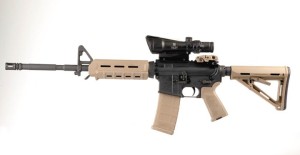 The AR-15 is a lightweight, intermediate cartridge, magazine-fed, air-cooled, semi automatic rifle with a rotating locking bolt, operated by direct impingement of gas on the gas key located on top of the bolt carrier or by short stroke piston action used to actuate the bolt carrier group. It has been produced in many different versions, including numerous semi-automatic, burst, and fully automatic variants. It is manufactured with extensive use of aluminum alloys and synthetic materials.
The AR-15 is a lightweight, intermediate cartridge, magazine-fed, air-cooled, semi automatic rifle with a rotating locking bolt, operated by direct impingement of gas on the gas key located on top of the bolt carrier or by short stroke piston action used to actuate the bolt carrier group. It has been produced in many different versions, including numerous semi-automatic, burst, and fully automatic variants. It is manufactured with extensive use of aluminum alloys and synthetic materials.
The AR-15 was first built in 1959 by ArmaLite as a small arms rifle for the United States armed forces. Because of financial problems, ArmaLite sold the design to Colt. After some modifications, the redesigned rifle was adopted as the M16 rifle. In 1963, Colt started selling the semi-automatic version of the rifle for civilians designated as the Colt SP1. Although the name “AR-15” remains a Colt registered trademark, variants of the firearm are made, modified, and sold under various names by multiple manufacturers.
AK-47
The AK-47 is a Gas Operated rifle that shoots 7.62 x 39mm Soviet ammunition. With a maximum capacity of 30 rounds, the AK-47 holds significantly more than most other rifles of the same caliber.
The average 7.62 x 39mm Soviet bullet has 1,526 ft-lbs. of energy at the muzzle, which is more powerful than the average rifle’s round 1,291 ft-lbs. On average, this round has a muzzle velocity of 2,360 fps , a speed that is faster than other rifle rounds.
The AK-47 (also known as the Kalashnikov, AK, or in Russian slang, Kalash) is a selective-fire (semi-automatic and automatic), gas-operated 7.62×39mm assault rifle, developed in the Soviet Union by Mikhail Kalashnikov. It is officially known in the Soviet documentation as Avtomat Kalashnikova (Russian: Автомат Калашникова).
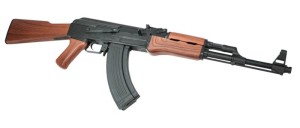 Design work on the AK-47 began in the last year of World War II (1945). In 1946, the AK-47 was presented for official military trials, and in 1948, the fixed-stock version was introduced into active service with selected units of the Soviet Army. An early development of the design was the AKS (S—Skladnoy or “folding”), which was equipped with an underfolding metal shoulder stock. In 1949, the AK-47 was officially accepted by the Soviet Armed Forces and used by the majority of the member states of the Warsaw Pact.
Design work on the AK-47 began in the last year of World War II (1945). In 1946, the AK-47 was presented for official military trials, and in 1948, the fixed-stock version was introduced into active service with selected units of the Soviet Army. An early development of the design was the AKS (S—Skladnoy or “folding”), which was equipped with an underfolding metal shoulder stock. In 1949, the AK-47 was officially accepted by the Soviet Armed Forces and used by the majority of the member states of the Warsaw Pact.
Even after almost seven decades, the model and its variants remain the most popular and widely used assault rifles in the world because of their substantial reliability under harsh conditions, low production costs compared to contemporary Western weapons, availability in virtually every geographic region and ease of use. The AK-47 has been manufactured in many countries and has seen service with armed forces as well as irregular forces worldwide, and was the basis for developing many other types of individual and crew-served firearms. As of 2004…”Of the estimated 500 million firearms worldwide, approximately 100 million belong to the Kalashnikov family, three-quarters of which are AK-47s”.
HK-93
In the mid to late 1960s, Heckler & Koch developed the HK33, which was a scaled-down version of the Heckler & Koch G3, but chambered for 5.56×45mm NATO. The HK33 entered production in 1968. In 1974, a semi-automatic version of the HK33 was introduced by H&K and was  designated the HK43. According to H&K’s numbering nomenclature, the “4” indicates that the weapon is a paramilitary rifle, and the “3” indicates that the caliber is .223.
designated the HK43. According to H&K’s numbering nomenclature, the “4” indicates that the weapon is a paramilitary rifle, and the “3” indicates that the caliber is .223.
A HK43 version KA1 with a shorter 322 mm barrel was used in 1977 by the German RAF terrorist group to assassinate general attorney Siegfried Buback and two policemen.
Today, an original HK43 can sell for around $5000 due to rarity. HK43s were sold with 25-round steel magazines. Of the approximately 377 HK43s produced, it is estimated that about 200 were imported by SACO into the U.S in 1974.
FN FAL
 The Fusil Automatique Léger (“Light Automatic Rifle”) or FAL is a semi-automatic/selective fire battle rifle produced by the Belgian armaments manufacturer Fabrique Nationale de Herstal (FN). During the Cold War it was adopted by many North Atlantic Treaty Organization (NATO) countries, with the notable exception of the United States. It is one of the most widely used rifles in history, having been used by more than 90 countries.
The Fusil Automatique Léger (“Light Automatic Rifle”) or FAL is a semi-automatic/selective fire battle rifle produced by the Belgian armaments manufacturer Fabrique Nationale de Herstal (FN). During the Cold War it was adopted by many North Atlantic Treaty Organization (NATO) countries, with the notable exception of the United States. It is one of the most widely used rifles in history, having been used by more than 90 countries.
The FAL was predominantly chambered for the 7.62×51mm NATO round (although originally designed for the .280 British intermediate cartridge) and because of its prevalence and widespread use among the armed forces of many NATO countries during the Cold War it was nicknamed “The right arm of the Free World”.
A British Commonwealth derivative of the FN FAL has been produced under licence as the L1A1 Self-Loading Rifle.
Škorpion
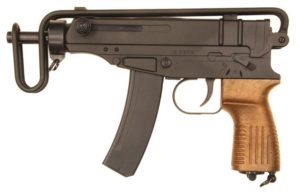
The Škorpion vz. 61 is a Czechoslovak 7.65 mm machine pistol developed in 1959 by Miroslav Rybář (1924–1970) and produced under the official designation Samopal vzor 61 (“submachine gun model 1961”) by the Česká zbrojovka arms factory in Uherský Brod from 1961 to 1979.
Although it was developed for use with security forces and special forces, the weapon was also accepted into service with the Czechoslovak Army, as a personal sidearm for lower-ranking army staff, vehicle drivers, armoured vehicle personnel and special forces. Currently the weapon is in use with the armed forces of several countries as a sidearm. The Škorpion was also licence-built in Yugoslavia, designated M84. It features a synthetic pistol grip compared to the original version. A civilian, semi-automatic version was also produced, known as the M84A, also available in .380 ACP (9×17mm Short).
UZI
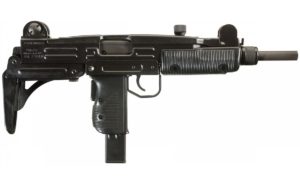
The Uzi (Hebrew: עוזי, officially cased as UZI) pronunciation: Listeni/ˈuːzi/ is a family of Israeli open-bolt, blowback-operated submachine guns. Smaller variants are considered to be machine pistols. The Uzi was one of the first weapons to use a telescoping bolt design which allows the magazine to be housed in the pistol grip for a shorter weapon.
The first Uzi submachine gun was designed by Major Uziel Gal in the late 1940s. The prototype was finished in 1950. First introduced to IDF special forces in 1954, the weapon was placed into general issue two years later. The Uzi has found use as a personal defense weapon by rear-echelon troops, officers, artillery troops and tankers, as well as a frontline weapon by elite light infantry assault forces.
The Uzi has been exported to over 90 countries. Over its service lifetime, it has been manufactured by Israel Military Industries, FN Herstal, and other manufacturers. From the 1960s through the 1980s, more Uzi submachine guns were sold to more military, law enforcement and security markets than any other submachine gun ever made.
RUGER 10/22
 The Ruger 10/22 Carbine is a Semi-Automatic rifle that shoots .22 LR ammunition. With a maximum capacity of 10 rounds, the Ruger 10/22 Carbine holds an average amount compared to other rifles of the same caliber. Ruger suggests a retail price of $279, which is less than the average .22 LR rifle.
The Ruger 10/22 Carbine is a Semi-Automatic rifle that shoots .22 LR ammunition. With a maximum capacity of 10 rounds, the Ruger 10/22 Carbine holds an average amount compared to other rifles of the same caliber. Ruger suggests a retail price of $279, which is less than the average .22 LR rifle.
The average .22 LR bullet has 124 ft-lbs. of energy at the muzzle, which is less powerful than the average rifle’s round 1,291 ft-lbs. On average, this round has a muzzle velocity of 1,218 fps , which is somewhat slower than other rifle rounds.
A magnum version, chambered for the .22 WMR cartridge, was made from 1998 to 2006, and a .17 HMR version, the 10/17 was announced in 2004, but was only listed in the catalog for two years. The standard version has been in production continuously since 1964.
IWI Tavor TAR-21
The Israel Weapon Industries Tavor TAR 21 is a Gas Operated and Semi-Automatic rifle that shoots 5.56mm NATO ammunition. With a maximum capacity of 30 rounds, the Israel Weapon Industries Tavor TAR 21 holds an average amount compared to other rifles of the same caliber. Israel 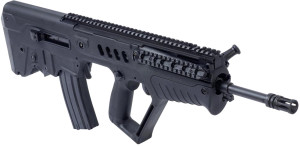 Weapon Industries suggests a retail price of $1,999, which is a lot more than average for a rifle.
Weapon Industries suggests a retail price of $1,999, which is a lot more than average for a rifle.
On average, this round has a muzzle velocity of 3,220 fps rifle rounds.
The TAR-21 (or simply Tavor) is an Israeli bullpup assault rifle chambered for 5.56×45mm NATO ammunition with a selective fire system, selecting between semi-automatic mode and full automatic fire mode. It is manufactured by Israel Weapon Industries (IWI).
Built around a long-stroke piston system (as found in the M1 Garand and AK-47), the Tavor was designed to maximize reliability, durability, and ease of maintenance, particularly under adverse or battlefield conditions.
In 2009, the X-95 (MTAR-21) was selected by the IDF to gradually replace the M16 rifle variants as the standard issued weapon of the Israeli infantry by the end of 2018.
SIG Sauer 556xi
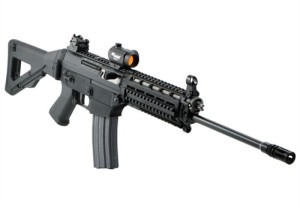 The SIG Sauer 556xi is a Semi-Automatic rifle that shoots 5.56mm NATO ammunition. With a maximum capacity of 30 rounds, the SIG Sauer 556xi holds an average amount compared to other rifles of the same caliber.
The SIG Sauer 556xi is a Semi-Automatic rifle that shoots 5.56mm NATO ammunition. With a maximum capacity of 30 rounds, the SIG Sauer 556xi holds an average amount compared to other rifles of the same caliber.
Powerful and reliable, the SIG Sauer 556xi Semiautomatic Tactical Rifle offers unparalleled modularity in barrel length, caliber, magazine type and stock configuration. A three-position adjustable gas-piston operating system with a rotating bolt keeps the rifle cooler and cleaner, increasing accuracy and reliability. Also features ambidextrous magazine release, bolt release, safety selector, charging handle, Swiss-style folding stock with removable cheek riser and locking flip-up front and rear sights.
M1 Carbine
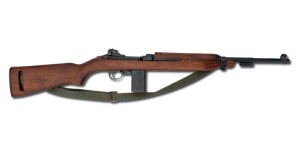 The M1 carbine (formally the United States Carbine, Caliber .30, M1) is a lightweight .30 caliber semi-automatic carbine that became a standard firearm for the U.S. military during World War II, the Korean War and the Vietnam War, and was produced in several variants. Easy to use, it was widely used by U.S. and foreign military, paramilitary and police forces, and has also been a popular civilian firearm.
The M1 carbine (formally the United States Carbine, Caliber .30, M1) is a lightweight .30 caliber semi-automatic carbine that became a standard firearm for the U.S. military during World War II, the Korean War and the Vietnam War, and was produced in several variants. Easy to use, it was widely used by U.S. and foreign military, paramilitary and police forces, and has also been a popular civilian firearm.
In selective-fire versions capable of fully automatic firing, the carbine is designated the M2 carbine. The M3 carbine was an M1 or M2 with an active infrared scope system. Unlike conventional carbines, which are generally shorter-barreled versions of a longer parent rifle (like the earlier .30-40 U.S. Krag rifle and carbine and the later M16 rifle and M4 carbine), the M1 carbine fires a different cartridge and has only one part, a short buttplate screw, in common with the M1 rifle.
THOMPSON SUBMACHINE GUN
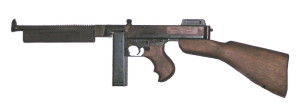 The Thompson submachine gun is an American submachine gun, invented by John T. Thompson in 1918, that became infamous during the Prohibition era. It was a common sight in the media of the time, being used by both law enforcement officers and criminals. The Thompson was also known informally as the “Tommy Gun”, “Trench Broom”, “Trench Sweeper”, “Chicago Typewriter”, “Chicago Piano”, “Chicago Style”, “Chicago Organ Grinder”, and “The Chopper”.
The Thompson submachine gun is an American submachine gun, invented by John T. Thompson in 1918, that became infamous during the Prohibition era. It was a common sight in the media of the time, being used by both law enforcement officers and criminals. The Thompson was also known informally as the “Tommy Gun”, “Trench Broom”, “Trench Sweeper”, “Chicago Typewriter”, “Chicago Piano”, “Chicago Style”, “Chicago Organ Grinder”, and “The Chopper”.
The Thompson was favored by soldiers, criminals, police and civilians alike for its large .45 ACP cartridge, accuracy, and high volume of automatic fire. It has since gained popularity among civilian collectors for its historical significance.
M1 GARAND
The M1 Garand (officially designated as U. S. rifle, caliber .30, M1, later simply called Rifle, Caliber .30, M1, also called US Rifle, Cal. .30, M1) is a semi-automatic rifle chambered for the .30-06 Springfield rifle cartridge, used by the United States Army from 1936 to 1959. The rifle was named after its designer John Garand. It was the first standard-issue semi-automatic military rifle. Called “the greatest battle implement ever devised” by General George S. Patton, the Garand officially replaced the bolt-action M1903 Springfield as the standard service rifle of the United States Armed Forces in 1936 and was subsequently replaced by the selective-fire M14, starting in 1959. During World War II, the M1 gave U.S. forces a distinct advantage in firefights against their Axis enemies, as their standard-issue rifles were more effective than the Axis’ slower-firing bolt-action rifles. The M1 continued to be used in large numbers until 1963 and to a lesser degree until 1976. Like its predecessor, the M1 originated from the Springfield Armory. Today, the M1 remains in use for drill purposes.
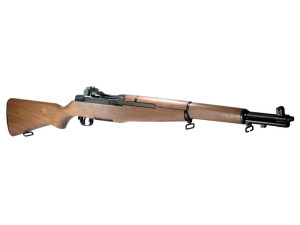 The M1 is an air-cooled, gas-operated, clip-fed, semi-automatic, shoulder-fired weapon. This means that the air cools the barrel; that the power to cock the rifle and chamber the succeeding round comes from the expanding gas of the round fired previously; that it is loaded by inserting an en-bloc (i.e., it goes into the rifle’s action and functions as part of the rifle) metal clip (containing eight rounds) into the receiver; and that the rifle fires one round each time the trigger is pulled. After the eight rounds have been shot, the empty clip automatically ejects with an audible “ping” noise.
The M1 is an air-cooled, gas-operated, clip-fed, semi-automatic, shoulder-fired weapon. This means that the air cools the barrel; that the power to cock the rifle and chamber the succeeding round comes from the expanding gas of the round fired previously; that it is loaded by inserting an en-bloc (i.e., it goes into the rifle’s action and functions as part of the rifle) metal clip (containing eight rounds) into the receiver; and that the rifle fires one round each time the trigger is pulled. After the eight rounds have been shot, the empty clip automatically ejects with an audible “ping” noise.
The M1 was the standard-issue service rifle of the U.S. forces in World War II and the Korean War, and also saw service to a limited extent in the Vietnam War. Most M1 rifles were issued to U.S. forces, though many thousands were also lent or provided as foreign aid to American allies. The Garand is still used by drill teams and military honor guards. It is also widely sought by the civilian population as a hunting rifle, target rifle, and military collectible.
Although the name “Garand” is frequently pronounced /ɡəˈrænd/, according to experts and people who knew John Garand, the weapon’s designer, /ˈɡærənd/ (to rhyme with errand) is preferred. It is available for American civilian ownership through the Civilian Marksmanship Program.
Heckler & Koch MP5
 The Heckler & Koch MP5 (from German: Maschinenpistole 5, meaning machine pistol 5) is a 9mm submachine gun of German design, developed in the 1960s by a team of engineers from the German small arms manufacturer Heckler & Koch GmbH (H&K) of Oberndorf am Neckar. There are over 100 variants of the MP5, including a semi-automatic version.
The Heckler & Koch MP5 (from German: Maschinenpistole 5, meaning machine pistol 5) is a 9mm submachine gun of German design, developed in the 1960s by a team of engineers from the German small arms manufacturer Heckler & Koch GmbH (H&K) of Oberndorf am Neckar. There are over 100 variants of the MP5, including a semi-automatic version.
The MP5 is one of the most widely used submachine guns in the world, having been adopted by 40 nations and numerous military, law enforcement, intelligence, and security organizations. It is widely used by SWAT teams in North America.
In 1999, Heckler & Koch developed the Heckler & Koch UMP, the MP5’s successor; both are available as of 2015.
WALTHER P22
 The P22 is a semi-automatic pistol chambered for .22 LR rimfire ammunition, manufactured by Carl Walther GmbH Sportwaffen.
The P22 is a semi-automatic pistol chambered for .22 LR rimfire ammunition, manufactured by Carl Walther GmbH Sportwaffen.
The Walther P22 is a Double-Action/Single-Action pistol that shoots .22 LR ammunition. With a maximum capacity of 10 rounds, the Walther P22 holds an average amount compared to other pistols of the same caliber. Walther suggests a retail price of $300, which is less than the average .22 LR pistol.
The average .22 LR bullet has 124 ft-lbs. of energy at the muzzle, which is much less powerful than the average pistol’s round 338 ft-lbs. On average, this round has a muzzle velocity of 1,218 fps , making it one of the slowest pistol rounds.
BARETTA 92
The Beretta 92 (also Beretta 96 and Beretta 98) is a series of semi-automatic pistols designed and manufactured by B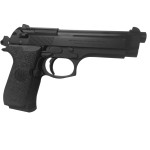 eretta of Italy. The model 92 was designed in 1972 and production of many variants in different calibers continues today. The United States Armed Forces replaced the Model 1911A1 .45 ACP pistol in 1985 with the military spec Beretta 92F, the M9.
eretta of Italy. The model 92 was designed in 1972 and production of many variants in different calibers continues today. The United States Armed Forces replaced the Model 1911A1 .45 ACP pistol in 1985 with the military spec Beretta 92F, the M9.
Beretta currently produces the pistol in four different configurations (FS, G, D and DS) and four calibers: 9×19mm Parabellum, .40 S&W, 9×21mm IMI and 7.65mm Luger.
GLOCK 19
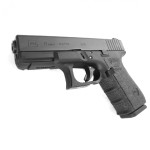 The Glock 19 is effectively a reduced-size Glock 17, called the “Compact” by the manufacturer. It was first produced in 1988, primarily for military and law enforcement. The Glock 19’s barrel and pistol grip are shorter by about 12 mm (0.5 in) compared to the Glock 17 and uses a magazine with a standard capacity of 15 rounds. The pistol is compatible with factory magazines from the Glock 17 and Glock 18, giving the Glock 19 available capacities of: 17 rounds (standard magazine with +2 extension), 10, 17, and 19 (standard Glock 17 magazine with +2), and the 31 (standard Glock 18 magazine with +2 removed) and 33 rounds of the Glock 18. To preserve the operational reliability of the short recoil system, the mass of the slide remains the same as in the Glock 17 from which it is derived. With the exception of the slide, frame, barrel, locking block, recoil spring, guide rod, and slide lock spring, all of the other components are interchangeable between the models 17 and 19.
The Glock 19 is effectively a reduced-size Glock 17, called the “Compact” by the manufacturer. It was first produced in 1988, primarily for military and law enforcement. The Glock 19’s barrel and pistol grip are shorter by about 12 mm (0.5 in) compared to the Glock 17 and uses a magazine with a standard capacity of 15 rounds. The pistol is compatible with factory magazines from the Glock 17 and Glock 18, giving the Glock 19 available capacities of: 17 rounds (standard magazine with +2 extension), 10, 17, and 19 (standard Glock 17 magazine with +2), and the 31 (standard Glock 18 magazine with +2 removed) and 33 rounds of the Glock 18. To preserve the operational reliability of the short recoil system, the mass of the slide remains the same as in the Glock 17 from which it is derived. With the exception of the slide, frame, barrel, locking block, recoil spring, guide rod, and slide lock spring, all of the other components are interchangeable between the models 17 and 19.
GLOCK 17
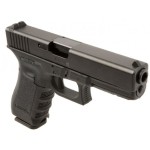 The Glock 17 is the original 9×19mm Parabellum model, with a standard magazine capacity of 17 rounds. Several modified versions of the Glock 17 have been introduced.
The Glock 17 is the original 9×19mm Parabellum model, with a standard magazine capacity of 17 rounds. Several modified versions of the Glock 17 have been introduced.
The Glock 17 is a Semi-Automatic and Short Recoil Operated pistol that shoots 9mm Luger ammunition. With a maximum capacity of 17 rounds, the Glock 17 holds more than the average pistols of the same caliber.
The average 9mm Luger bullet has 338 ft-lbs. of energy at the muzzle, which is comparable to the average pistol’s round 338 ft-lbs. On average, this round has a muzzle velocity of 1,104 fps , which is about average compared to other pistol rounds.
1911
 The M1911 is a single-action, semi-automatic, magazine-fed, recoil-operated pistol chambered for the .45 ACP cartridge. It served as the standard-issue sidearm for the United States Armed Forces from 1911 to 1986. It was first used in later stages of the Philippine–American War, and was widely used in World War I, World War II, the Korean War, and the Vietnam War. The pistol’s formal designation as of 1940 was Automatic Pistol, Caliber .45, M1911 for the original model of 1911 or Automatic Pistol, Caliber .45, M1911A1 for the M1911A1, adopted in 1924. The designation changed to Pistol, Caliber .45, Automatic, M1911A1 in the Vietnam era.
The M1911 is a single-action, semi-automatic, magazine-fed, recoil-operated pistol chambered for the .45 ACP cartridge. It served as the standard-issue sidearm for the United States Armed Forces from 1911 to 1986. It was first used in later stages of the Philippine–American War, and was widely used in World War I, World War II, the Korean War, and the Vietnam War. The pistol’s formal designation as of 1940 was Automatic Pistol, Caliber .45, M1911 for the original model of 1911 or Automatic Pistol, Caliber .45, M1911A1 for the M1911A1, adopted in 1924. The designation changed to Pistol, Caliber .45, Automatic, M1911A1 in the Vietnam era.
In total, the U.S. procured around 2.7 million M1911 and M1911A1 pistols in military contracts during its service life. The M1911 was replaced by the 9mm Beretta M9 pistol as the standard U.S. sidearm in October 1986, but due to its popularity among users, it has not been completely phased out. Modernized derivative variants of the M1911 are still in use by some units of the U.S. Army Special Forces, the U.S. Navy and U.S. Marine Corps.
Designed by John Browning, the M1911 is the best-known of his designs to use the short recoil principle in its basic design. The pistol was widely copied, and this operating system rose to become the preeminent type of the 20th century and of nearly all modern centerfire pistols. It is popular with civilian shooters in competitive events such as USPSA, IDPA, International Practical Shooting Confederation, and Bullseye shooting. Compact variants are popular civilian concealed carry weapons, because of the design’s relatively slim width and the power of the .45 ACP cartridge.
1911 .22LR (Suppressed)
The same look and feel of the 1911 pistol mentioned above, with the exception of the suppressor. This pistol fires a .22LR projectile and is a lot easier to handle than some of the pistol calibers available today and remains an inexpensive option for most shooters as well.
REVOLVER
A revolver is a repeating firearm that has a revolving cylinder containing multiple chambers and at least one barrel for firing. The term “revolver” refers to a handgun, but other weapons may also have a revolving chamber. These include some models of grenade launchers, shotguns, and rifles.
Though the original name was revolving gun, the short-hand “revolver” is universally used. (Cannon using this mechanism are known as revolver cannon.) Nearly all early revolvers and many modern ones have six chambers in the cylinder, giving rise to the slang term six-shooter; however, revolvers with a number of different chambers have been made, with most modern revolvers having 5 or 6 chambers.
The revolver allows the user to fire multiple rounds without reloading. Each time the user cocks the hammer, the cylinder revolves to align the next chamber and round with the hammer and barrel, which gives this type of firearm its name. In a single-action revolver, the user pulls the hammer back with his free hand or thumb; the trigger pull only releases the hammer. In a double-action revolver, pulling the trigger moves the hammer back, then releases it, which requires a longer and heavier trigger pull than single-action. Loading and unloading a double-action revolver requires the operator to swing out the cylinder and insert the proper ammunition, all while keeping the gun pointed in a safe direction.
